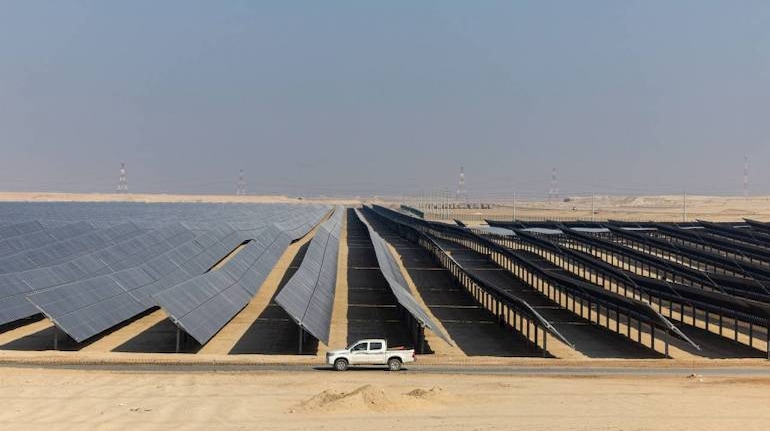



How do you ban a technology without outlawing it? One way is to throw up obscure regulations that make it all but impossible for developers to go ahead. That’s what happened in the UK in 2015, when a little-noticed tweak to planning laws brought a booming onshore wind sector to a juddering halt by making it easier for local objectors to stop development.
Something similar is happening with trade law. A growing range of mandates and incentives — introduced with the admirable-sounding intention of building up local clean power industries — are throwing sand in the gears of the supply chains needed to build energy systems fit for the 21st century.
So-called local content requirements or LCRs can be found in everything from Indonesian solar power plants to US wind farms and electric cars. They appear to be proliferating. The number of countries where they’re in force doubled to 24 over the decade through 2021, according to Megan Hogan, an analyst at the Peterson Institute for International Economics.
Such rules run clearly counter to trade laws — but with a rising focus on energy as a national security issue, and the weakening of the World Trade Organisation since the Trump administration gutted its highest body in 2019, there’s little sign the rising tide is about to reverse. That’s worrying. Like the UK’s planning laws, LCRs can seem modest, even benign. In practice, they can be almost as effective as a legislated ban.
Consider South Africa. The country’s power system has been breaking down for more than a decade, leaving the country plagued by rolling blackouts after billions were wasted and filched from the state-owned generator Eskom Holdings SOC Ltd Solar panels would seem a good solution to that problem, allowing households and businesses to generate their own electricity when the grid falls down, much as back-up diesel generators do in less affluent parts of Africa.
Despite that, they’re incredibly rare: Just 1.04 gigawatts of commercial and residential panels were installed across the country in 2021, according to BloombergNEF, compared to 17 gigawatts in Australia, a country that’s similarly blessed with ample sunshine. Over the decade through 2021, solar and wind went from providing 3.5 percent of Australia’s electricity to 20 percent. In South Africa, it went from zero to 6.4 percent.
One part of the explanation is that Australia imposes few restrictions on where its renewable equipment is made, whereas South Africa waited until January this year to relax rules requiring that 100 percent of materials in solar panels be produced locally. (Fossil fuels have been treated more leniently, with only 60 percent local content required for the vast, still-incomplete Medupi and Kusile coal-fired power plants.)
Countries that lack a renewables equipment industry might assume that LCRs could usher one into life. In truth, they present a chicken-and-egg problem. Manufacturers won’t invest unless they’re confident there will be an end market for their products — but developers won’t sign contracts to sell electricity and put in orders for panels and turbines unless they’re sure that factories can deliver on time and on budget. That’s a difficult ask in countries like South Africa, where the entire manufacturing sector struggles — not least because of the instability of the power grid that more energy investment might fix.
Such rules may be most obscene in countries like Ghana, Morocco, Saudi Arabia and South Africa, which lack the complex manufacturing sectors capable of delivering the equipment they mandate. They may be most pernicious, however, in larger countries where supply chains will be built, but at a higher cost and smaller scale than the transition away from fossil fuels requires.
A growing body of research has shown that renewable LCRs are quite effective at making zero-carbon technology more expensive, but fall down when it comes to fostering industrial expertise. One 2020 study found that the rules lifted the cost of Indian solar power by about 6 percent, but still failed to prevent local production from losing market share to cheaper imports.
Paradoxically, it’s precisely the importance placed on the energy transition that allows LCRs to flourish. Governments don’t much care if their disposable plastic cups or shoelaces are made in China — but power generation is seen as more strategic, and thus more worthy of protection. That just puts another thumb on the scales to offset the fundamental economic advantages of zero-carbon power. Fossil fuel generators in most countries don’t have to pay a cent for the health and climate costs of their pollution. Renewable competitors, meanwhile, typically have to absorb the cost of stabilising power grids and often shoulder the expense of onerous take-or-pay coal contracts agreed years ago. Increasingly, they have to subsidize sub-economic local manufacturing sectors as well.
For generations after World War II, Latin American nations pursued a policy of import substitution industrialisation — raising high tariff barriers to build up local manufacturers. They ended up saddled with debt, with sclerotic factory sectors that fell far behind the Asian tiger economies who’d opened themselves up to trade. The world has only 30 years or so to switch its energy systems to a more sustainable basis. We can’t afford to lose decades to a new wave of protectionism.
David Fickling is a Bloomberg Opinion columnist covering energy and commodities.
Credit: Bloomberg
Discover the latest Business News, Sensex, and Nifty updates. Obtain Personal Finance insights, tax queries, and expert opinions on Moneycontrol or download the Moneycontrol App to stay updated!
Find the best of Al News in one place, specially curated for you every weekend.
Stay on top of the latest tech trends and biggest startup news.